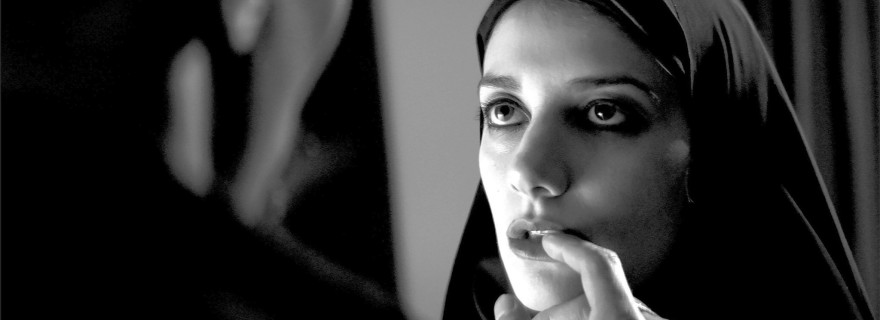'A Girl Walks Home Alone at Night'
Movie Rating:
3.5
Last year, we got a Jim Jarmusch hipster vampire movie, ‘Only Lovers Left Alive‘. Once that happened, the folks who made ‘A Girl Walks Home Alone at Night’ must have felt a little uncomfortable. Essentially, this is another Jarmusch-style vampire movie, but thankfully one with enough else going on that it can’t merely be dismissed as ‘Only Lovers Left Alive 2: Vampire Boogaloo’.
Ana Lily Amirpour’s directorial debut is a strange, haunting, thoughtful, and even playful little twist on vampire lore that announces the rise of an intriguing new filmmaker. Jarmusch jokes aside, there’s nothing else quite like it kicking around theaters right now. Those with a taste for vamps or the art house need to give it a look post-haste.
The film takes place in Bad City, an alternative nightmare version of Tehran shot in California. Tight-jeaned hipster Arash (Arash Marandi) is introduced as the initial protagonist. He’s a guy who likes to wander empty streets looking cool and staring pensively off into the distance. His father Hossein (Marshall Manesh) is an intravenous drug addict and perpetual burden. The two of them owe a chunk of change to what appears to be Bad City’s only criminal, the sleazy, tattooed, porn-‘stached drug dealer Saeed (Dominic Rains). Saeed also has a middle-aged prostitute named Atti (Mozhan Marno) on his payroll, and Hossein as a passion for harassing her.
Those four pathetic lives wander the streets and bump into each other for a while, when the title character appears. Credited only as “The Girl,” Sheila Vand plays a silent vampire whose room suggests that she was turned at some point in the 1980s and who likes to wear her black chador at night to sneak around the shadows and feast on the blood of men who abuse women. At a certain point, Arash meets The Girl while dressed as a vampire for a costume party, and pangs of love spring from both sides. From there, the creepy ambience continues, bad things happen to bad people (as well as some good ones), and the pain of eternal life is explored – all shot in gorgeously creepy low-fi black-and-white, backed by an all-Iranian hip neo-’80s soundtrack.
Make no mistake, ‘A Girl Walks Home Alone at Night’ is an absolutely gorgeous creation to get sucked up by your eyeholes and earholes. Clearly, that was Lily Amirpour’s primary interest in her first feature. She creates a movie with a woozy, eerie, cool and arty atmosphere that’s all too easy to get lost in. Her influences are worn boldly on her sleeve with grainy black-and-white cinematography out of ’80s Jarmusch, compositions and settings from underground comics, sound design and cityscapes inspired by ‘Eraserhead’, and pop politics borrowed from the recent feminist genre inversion of your choice. It’s a potent cocktail that establishes Amirpour’s voice through mixing some of her favorite voices together. The film has an undeniable sense of cool mixed together with pain, politics, horror and humor in just the right doses. The filmmaker has crafted a gentle nightmare to get enveloped within, easy to admire but perhaps a little too distant to inspire much emotional investment.
The low-rent, high-art mood is perked up by a collection of eccentric performances that bring life to the coldly composed frames. No one ever acts out beyond the movie’s sense of deadpan cool, but as Jarmusch proved long ago, there are plenty of emotional variations to that deliberately limited palate. Amirpour, along with her cast, explore most of them. The drive of the movie all comes from The Girl, whose enigmatic look and behavior never give too much away to viewers. She appears to be a feminist antihero with a perverse sense of justice in one scene, a lovelorn outsider in the next, a feral monster after that, and later a neurotic comedy figure. Those tonal shifts define Amirpour’s film as a whole, which is tough to pin down yet easy to get lost in.
Sure, this might be an exercise in affected cool, but it’s such an effective one that it’s hard to complain. Mood pieces are fickle beasts for filmmakers to master, and Amirpour has crafted a pretty damn evocative one despite never having mounted a feature before. Chances are, this debut will seem slight once she has a few more films under her belt. For now, it’s nice to simply savor such a singularly strange voice bridging the gap between the grindhouse and the art house.



